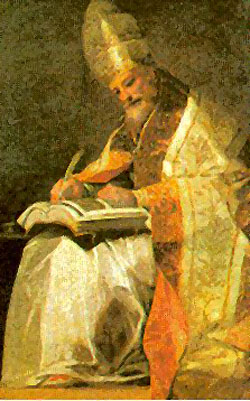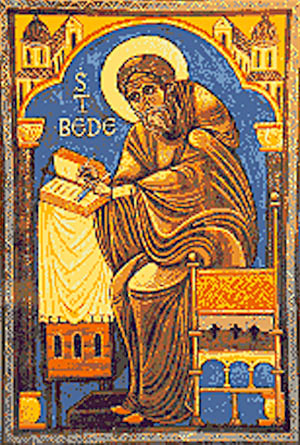 St Gregory VII - from here: The tenth century and the first half of the eleventh were dark days for the Church, partly because the papacy was the pawn of various Roman families. In 1049, things began to change when Pope Leo IX, a reformer, was elected. He brought a young monk named Hildebrand to Rome as his counselor and special representative on important missions. He was to become Gregory VII.
St Gregory VII - from here: The tenth century and the first half of the eleventh were dark days for the Church, partly because the papacy was the pawn of various Roman families. In 1049, things began to change when Pope Leo IX, a reformer, was elected. He brought a young monk named Hildebrand to Rome as his counselor and special representative on important missions. He was to become Gregory VII.Three evils plagued the Church then: simony (the buying and selling of sacred offices and things), the unlawful marriage of the clergy and lay investiture (kings and nobles controlling the appointment of Church officials). To all of these Hildebrand directed his reformer’s attention, first as counselor to the popes and later (1073-1085) as pope himself.
Gregory’s papal letters stress the role of bishop of Rome as the vicar of Christ and the visible center of unity in the Church. He is well known for his long dispute with Holy Roman Emperor Henry IV over who should control the selection of bishops and abbots.
Gregory fiercely resisted any attack on the liberty of the Church. For this he suffered and finally died in exile. He said, “I have loved justice and hated iniquity; therefore I die in exile.” Thirty years later the Church finally won its struggle against lay investiture.
 St Mary Magdalen of Pazzi - a vow of virginity at age 10 and she's still called "the ecstatic saint"? - from here: Mystical ecstasy is the elevation of the spirit to God in such a way that the person is aware of this union with God and both internal and external senses are detached from the sensible world. Mary Magdalene de Pazzi was so generously given this special gift of God that she is called the "ecstatic saint."
St Mary Magdalen of Pazzi - a vow of virginity at age 10 and she's still called "the ecstatic saint"? - from here: Mystical ecstasy is the elevation of the spirit to God in such a way that the person is aware of this union with God and both internal and external senses are detached from the sensible world. Mary Magdalene de Pazzi was so generously given this special gift of God that she is called the "ecstatic saint."She was born into a noble family in Florence in 1566. The normal course would have been for Catherine de Pazzi to have married wealth and enjoyed comfort, but she chose to follow her own path. At nine she learned to meditate from the family confessor. She made her first Communion at the then-early age of 10 and made a vow of virginity one month later. When 16, she entered the Carmelite convent in Florence because she could receive Communion daily there.
Catherine had taken the name Mary Magdalene and had been a novice for a year when she became critically ill. Death seemed near so her superiors let her make her profession of vows from a cot in the chapel in a private ceremony. Immediately after, she fell into an ecstasy that lasted about two hours. This was repeated after Communion on the following 40 mornings. These ecstasies were rich experiences of union with God and contained marvelous insights into divine truths.
As a safeguard against deception and to preserve the revelations, her confessor asked Mary Magdalene to dictate her experiences to sister secretaries. Over the next six years, five large volumes were filled. The first three books record ecstasies from May of 1584 through Pentecost week the following year. This week was a preparation for a severe five-year trial. The fourth book records that trial and the fifth is a collection of letters concerning reform and renewal. Another book, Admonitions, is a collection of her sayings arising from her experiences in the formation of women religious.
The extraordinary was ordinary for this saint. She read the thoughts of others and predicted future events. During her lifetime, she appeared to several persons in distant places and cured a number of sick people.
It would be easy to dwell on the ecstasies and pretend that Mary Magdalene only had spiritual highs. This is far from true. It seems that God permitted her this special closeness to prepare her for the five years of desolation that followed when she experienced spiritual dryness. She was plunged into a state of darkness in which she saw nothing but what was horrible in herself and all around her. She had violent temptations and endured great physical suffering. She died in 1607 at 41, and was canonized in 1669.
 St Bede - from here: Bede is one of the few saints honored as such even during his lifetime. His writings were filled with such faith and learning that even while he was still alive, a Church council ordered them to be read publicly in the churches.
St Bede - from here: Bede is one of the few saints honored as such even during his lifetime. His writings were filled with such faith and learning that even while he was still alive, a Church council ordered them to be read publicly in the churches.At an early age Bede was entrusted to the care of the abbot of the Monastery of St. Paul, Jarrow. The happy combination of genius and the instruction of scholarly, saintly monks produced a saint and an extraordinary scholar, perhaps the most outstanding one of his day. He was deeply versed in all the sciences of his times: natural philosophy, the philosophical principles of Aristotle, astronomy, arithmetic, grammar, ecclesiastical history, the lives of the saints and, especially, Holy Scripture. From the time of his ordination to the priesthood at 30 (he had been ordained deacon at 19) till his death, he was ever occupied with learning, writing and teaching. Besides the many books that he copied, he composed 45 of his own, including 30 commentaries on books of the Bible.
Although eagerly sought by kings and other notables, even Pope Sergius, Bede managed to remain in his own monastery till his death. Only once did he leave for a few months in order to teach in the school of the archbishop of York. Bede died in 735 praying his favorite prayer: “Glory be to the Father, and to the Son, and to the Holy Spirit. As in the beginning, so now, and forever.”
His Ecclesiastical History of the English People is commonly regarded as of decisive importance in the art and science of writing history. A golden age was coming to an end at the time of Bede’s death: It had fulfilled its purpose of preparing Western Christianity to assimilate the non-Roman barbarian North. Bede recognized the opening to a new day in the life of the Church even as it was happening.
No comments:
Post a Comment